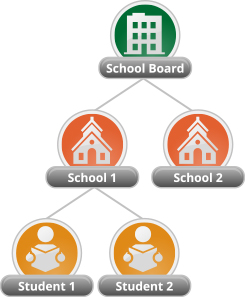
menu
Students live within a hierarchical social structure made up of classrooms, grades, schools, districts and so forth. Students who share the same environment and experiences tend to be more homogeneous with each other. It has been understood and proven that ignoring this aggregation when using conventional statistical methods may produce very misleading inferences about relationships among variables (e.g., misidentifying variables associated with school achievement, which can lead to the misallocation of resources from schools). Therefore, it is always desirable to take account of the impact of hierarchies on students’ achievement and other correlated variables.

The figure above illustrates a hierarchical social structure, as an example, in which students are nested within schools and schools are nested within a school board.
HLM (Hierarchical Linear Modeling) is a sound and useful statistical procedure for handling the complexity in hierarchical nested data which naturally exists in the educational system. It separately looks at the relationship between school and student variables with educational outcomes and therefore produces more accurate and reliable results. The results from an HLM analysis provide rich information for policy makers when making evidence-based decisions for improving the educational system. It has been highly regarded and widely used in education as well as other social science areas.
The common applications of HLM include doing inference tests for:
Grade 7 CAT•4 Math achievement for school board A.
| Significant factors | Estimate | Interpretation |
|---|---|---|
| Average increment in student's Math scale score within school for... | ||
| Year | 2.10 | On average students grew 2.10 scale scores between two years. |
| students who are ELL | -5.32 | students who are ELL -5.32 Students who were ELL on average got 5.32 points lower on the test than non-ELL. |
| students who are female | 1.12 | Girls on average got 1.12 points higher than boys. |
| Average increment in school mean CAT scale score for... | ||
| Year | 1.71 | On average schools grew 1.71 point of scale score between two years. |
| Program type in school | 2.23 | Schools having French immersion programs per-formed significantly better than the rest by 2.23 points. |
| Average class size in school | -3.12 | Schools having smaller average class size per-formed significantly better then schools having bigger class size by 3.12 points. |
| Average increment in school growth speed for... | ||
| Intervention in school | 1.01 | Schools providing intervention on average grew faster than schools not providing intervention by 1.01 points between two years. |
| Parental involvement in school (or other school culture variables) | 0.05 | Schools where parents are more involved on average grew faster than schools where parents are less involved by 0.5 point between two years. |
For more information on our Customized Services, please contact the Canadian Test Centre at info@canadiantestcentre.com